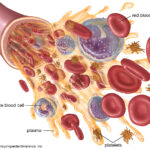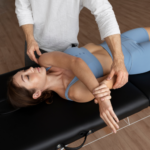Definition
Patellofemoral Pain Syndrome (PFPS) is more commonly known as runner’s or jumper’s knee. It’s a very common condition that can affects athletes and non-athletes, around 3 million people in the US per year.
Symptoms
PFPS symptoms are described as a dull, achy pain under or on top of the kneecap, stiffness, sometimes with swelling, especially noted after exercise. This pain can become aggravated when walking up or down stairs, hills, sitting with knees bent for extended periods or when a person squats or kneels.
![[1]](https://images.squarespace-cdn.com/content/v1/568c1797df40f37b331c4d04/1525198409785-Z7B3PU16RGG0ESL0Q37R/%5B1%5D)
[1]
Causes
There is no exact cause, however the pain can be attributed to overuse, intense lower body workouts combined with not giving your body proper recovery time in between. Muscular imbalance around the knee joint which can lead to misalignment of the patella . Prior injury or surgery to the knee can also cause this pain. These issues can cause inflammation and lead to the cartilage rubbing within the knee joint, as opposed to gliding smoothly.
Treatment
Only a doctor or properly trained professional can diagnose this condition. Treatment usually starts with rest, and ice, also avoiding the actions that cause pain. A doctor may recommend anti-inflammatory medication or orthotics to help. Performing exercises to strengthen weaker muscles and stretches to decrease tightness in the muscles surrounding the knee joint. Sports massage can help loosen tight muscles and can be an important part of recovery.
Prevention
- Proper alignment of the hip, knee and ankle joints while exercising (squatting and lunging especially)
- Warming up beforehand and gradually increasing the intensity of workouts.
- Giving your body recovery time while training.
- Choose proper footwear for the activity
- Regular massage for maintenance
- Maintain strength and flexibility with regular stretching of the hips, ITB, hamstrings and quadriceps, along with exercise to strengthen them.
Below are a few stretches that can help alleviate tightness. On the left is an ITB stretch [2] and in the middle is a hamstring stretch [3]. The last stretch is one for the Quads [4]. The calf stretches mentioned in
last month’s article can also be beneficial.
With proper care, PFPS can usually be resolved in a few weeks. Afterwards, keeping up with regular self care is a great way to keep it from coming back and keeping you moving through your daily activities and life.
Picture references (viewed 5/1/18):
- https://www.braceability.com/blog/6-exercises-and-stretches-for-patellofemoral-pain-syndrome-and-3-to-avoid/
- http://www.physicaltherapyfirst.com/mobile-it-band-stretch/
- https://www.popsugar.com/fitness/photo-gallery/1983373/image/20673114/Reclined-Hamstring-Stretch
- https://www.popsugar.com/fitness/photo-gallery/3060365/image/31056524/Lying-Side-Quad-Stretch
References (viewed 5/1/18):
- https://www.braceability.com/blog/6-exercises-and-stretches-for-patellofemoral-pain-syndrome-and-3-to-avoid/
- https://www.mayoclinic.org/diseases-conditions/patellofemoral-pain-syndrome/symptoms-causes/syc-20350792
- https://orthoinfo.aaos.org/en/diseases–conditions/patellofemoral-pain-syndrome/
- http://www.sportsinjuryclinic.net/sport-injuries/knee-pain/patellofemoral-pain-syndrome
- https://www.webmd.com/pain-management/knee-pain/tc/patellofemoral-pain-syndrome-topic-overview
This article/video is for educational purposes only; do not attempt without your physician’s clearance. If you are in pain or injured, see your physician.
Copyright © Vidal Sports LLC 2018










